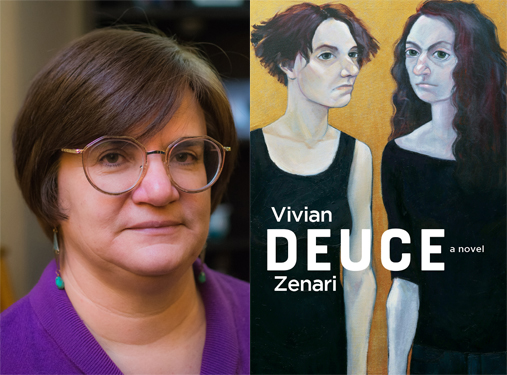Characters Are (Not) People
by Vivian Zenari
I know that Philippa and Gilda Peterborough, the protagonists of my first novel, Deuce, are not real people. If I saw either of them on the street, though, I’m sure I would recognize them.
#
When I distinguish between characters in fiction and people in the real world, I’m distinguishing between characters and people. Characters are simulations of people in a fictional world. Nevertheless, an overlap lies between these two worlds. The “real world” has me in it, as well as you (the reader—hi, there!). In the past, it contained the living beings Napoleon Bonaparte, Hildegard of Bingen, and Confucius, among others. These three persons, among so many trillions of living things, inorganic objects, energy fields, and all the other stuff of the universe, have existed in this shared realm. Some of these entities have physical remnants of themselves that serve as evidence of their presence, although some of those remnants have disappeared through the real world’s entropic nature.
I don’t, however, think that fictional worlds are not real. Books that people write have an actuality that is material and psychic. On my bookshelf behind me and my typing self, for example, sits George Eliot’s Middlemarch. That volume is a physical copy of, many generations removed from yet contiguous to, the manuscript that Mary Ann Evans used to communicate to her imagined readers the places, people, and events that constitute the content of her novel. Along with the physical object, both the original and its copies, however, is the discursive effect of that content, 200 years’ worth of ideas and musings from direct readers and from commentators (whether they’ve read Middlemarch or not). The discourse around Middlemarch is real, not fake, false, or fictional. Out of actual brains and mouths have flown Middlemarch-based thoughts, images, and words, some recorded and preserved, but most not. In their ephemerality, much has been lost to the present moment, but they did once exist.
The more a novel tries to imitate the real world, the more obvious the overlap seems—or, I should say, is. Only the most extreme speculative fiction fights against its kinship with the real world. Eliot attempted to represent in Middlemarch an England that was indistinguishable from hers at the time she wrote it. By comparison, JRR Tolkien’s The Lord of the Rings hardly seems like this world at all: it has magic, non-human sentient beings, and a geography that doesn’t resemble any that the real world’s Earth has had. Nevertheless, the fictional Middle Earth and the real-world Earth intersect. Hobbit homes have parlours, elves ride horses, and Frodo and Gollum, on their march to Mordor, rest under an oak tree. Tolkien retained enough of the real world that the Shire is like a version of England, not as close a version as in Eliot’s novel, but close enough.
Those who say that fiction is not real, therefore, ignore, maybe willfully so, how closely fiction clings to the real world.
#
I consider Deuce to be a character-centred novel. My goal was to put characters in a context and see what they do. As a result, I wanted them to behave like close imitations of people. I tried to make them “real” by piling on details, both physical and psychological. Lived life is full of details, and the more details there are, the more the characters will seem like people.
Perhaps some readers believe that all writing is autobiographical and assume all my characters, for example, are explicitly patterned on particular people. But no: no one in Deuce is patterned on a particular person I know. I can’t deny that there may be overlap. That’s because I’m in the real world, and it overlaps with the fictional one. Deuce is set in three real-world communities, Edmonton, Lamoureux, and Montreal. Because these settings are demonstrably in the real world, I picked as many details as I could from these places so that the novel seemed real. I didn’t, though, deliberately pattern a character on a real person I know. I did take bits and pieces of my life experience, which includes my knowledge of other people to fill out the spectrum of detail that I wanted. The more important the character, the more details I needed.
The details I use to compose my characters have led me to believe that they are versions not of other people but of me. The Peterborough twins, their mother and father, their bosses, their coworkers, and their friends, even the kid who keeps trying to shoplift games from Tokens, no matter the age or gender, resemble me more than anyone I know. They reflect my experience, that is, and therefore they reflect me.
I know, though, that none of the characters are me, and in the end, I am not them. There is overlap, but not equality.
#
If I saw Philippa, Gilda, or the Tokens shoplifter walk by me on the street, I wouldn’t bother them. They’re working, I’d tell myself. I’d best leave them alone.
Born in Edmonton to Italian immigrant parents, Vivian Zenari has worked as a librarian, technical editor and post-secondary instructor of English literature and writing. Vivian has a PhD from the University of Alberta with a thesis on nineteenth-century American literature. Currently, Vivian works for Athabasca University, where she teaches grammar, introduction to poetry and drama, film and literature, creative nonfiction and fiction. Her writing has been published in literary magazines and journals, and her work has been included in a number of academic publications. She lives in Edmonton with her son, husband and cat. Deuce is her debut novel. www.vivianzenari.com

